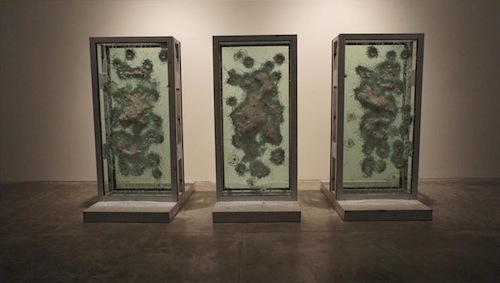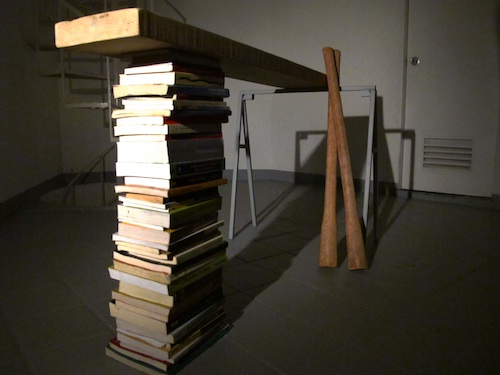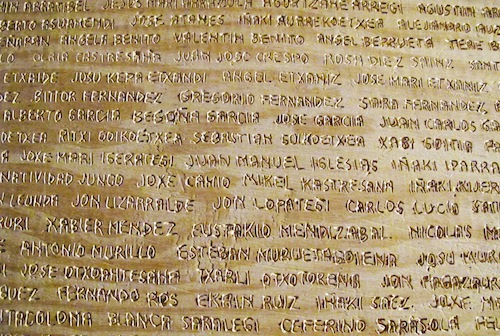
Daniel Godínez. "Canción de Cuna (Lullaby)," from Partituras Finales (Final Scores), part of Asamblea.
For this guest post, I invited Israel Martínez to contribute an essay. Martínez is a Mexican new media artist and electronic musician who works with sound as his main medium and concern. Martínez got the Distinction Award at Prix Ars Electronica 2007 in the Digital Music category and his albums have been published by Sub Rosa and Aagoo Records; El hombre que se sofoca was named #4 in SPIN Magazine’s list of 20 Best Avant Albums of 2011. He will live and work in Germany thanks to a fellowship from the German Academic Exchange System in 2012-2013. His most recent exhibit was the solo show Public, Private and Other Impositions at Quiet Cue in Berlin.
[Ed. note: Martínez’s post was translated by Mariana Aguirre]
Sound as medium or prime resource for the production of a piece, regardless of its origin or whether or not it is labeled as sound art or linked to experimental music, is becoming more and more common in many contemporary artists’ practices. We can say that the relation between artists and the aural has evolved from being an inspiration that emanates from the stereo or computer while one is drawing or cutting materials or objects for an installation, to being taken into consideration as a field of study in relation to social phenomena, or as an effective medium for the transmission of ideas. In Mexico, sound appears prominently in the work of several artists belonging to different generations.
Tania Candiani recently presented an intervention at the Hotel Condesa in Mexico City, Plataforma Sonora, a structure in the shape of a triangular prism that hangs from the building’s most elevated patio. The piece is covered by sixteen aluminum trumpets. Audiences hear a simple composition based on thirty wind-up clocks that were recorded previously, each of them separately. The intervention to the space is not only sculptural and on-site, the “sound of time” invites us to revise our notions of the present and memory, our dependence on temporality: date books, schedules, physical activity and how these are translated into results, as well as sleep and rest. The aural portion’s meticulous recording process and composition, as well as the conscientious production of the sculptural portion, allow this work to disengage itself from other, similar sound pieces that are lacking in terms of the spatial aspect and the object itself.
Candiani is currently preparing the exhibit Cinco Variaciones de Circunstancias Fónicas y una Pausa (Five Variations of Phonic Circumstances and One Pause), to be presented in the fall at the Laboratorio de Arte Alameda, also in Mexico City. This project develops a theme that Candiani has followed closely: the exploration of machinery and its relation to man and communication, how messages are transmitted and decodified based on different uses of technology, and in the case of this project, based on listening, rhythm, aural texture, memory and free association. For example, an organ made up of two keyboards will be placed in the ex-Convento de San Diego’s choir. One of the keyboards is a typewriter, which allows one to hear phrases written by using a computerized voice processor when shifting to the next line by activating a car’s gearshift. The other keyboard is musical and has been programmed to emit a phonic syllable, managing to utter up to 1,200 syllables. In the video installation Pause, several Mexican writers recount a story to a scribner so he can materialize it through his tool and a physical comparison of the interpretation can exist: a variation and rewriting of the first document. Another piece will take place in the church’s bell tower, as a tower of speakers will be installed so that a muadhdhin, in this case the composer Rogelio Sosa, can sound a call to the community near the museum from 6 am until noon in a continuous crescendo; the volume will decrease during the following six hours.
Iván Edeza, who also collaborates in Candiani’s project, is an artist who since the nineties has mostly worked with video. He pays great attention to each of his work’s aural components by including segments of industrial or experimental music to the minimal processing of ambient sound captured by his camera, or even, silence. In one of his recent works, Guatemala, the interior of a cavernous space is barely visible; the frame, somewhat unclear, becomes even more enigmatic due to a mask added by the artist during the editing process and physically highlighted by manipulating the projector. The only clear element is the sobbing and prayers of what appear to be dozens of mourning women. The surround sound envelops us in this strange and, to a certain degree, strident, halo.
https://vimeo.com/43075207
This recording was realized in a chapel inside the church of Santiago Atitlán, in Guatemala, one of the hundreds of towns that has suffered the consequences of scorched earth policies, especially during president Ríos Montt’s term. The women belong to a Mayan ethnic group and were recorded while they wailed by using a lavalier wireless microphone, while a camera, unattended by Edeza, accidentally registered the floor and some tourists taking photographs. The strength of the sound provokes these associations only after the spectator-listener spends a considerable number of minutes absorbed by doubt in the dark space.
Edeza’s work was presented as part of the exhibit Densidad at the Galería Metropolitana in Mexico City, in which Enrique Ježik, who had just had an important retrospective at the Museo Universitario de Arte Contemporáneo (MUAC), participated as well. In the former exhibit, Ježik presented La fiesta de las balas (The bullets’ party), which featured three steel and glass structures measuring a little over two meters, with three hundred bullet holes that were done by using 9mm revolvers, 12 caliber shotguns and free range rifles, all of which are the property of Seguridad Pública (Department of Public Safety). In the galleries we could hear the violent sound of each of the shots, as if we were at a shooting range. The bullets’ “presence,” both aural and as registered in the structures, puts arms development on the table–which is a sticky topic in a society based on corruption such as the Mexican one. How many of these bullets have reached a target that is not related to crime? Or, how many of these weapons go from being sold legally into the black market that ends up supplying the “other guys”? Yet another bullet struck the speakers as I attempted to trace this potential transit.
Two recent projects by young Mexican artists have shown the effects of the relation between society and politics through music and collectivity, terms that are usually associated with business, spectacle and the culture industry. There is no relation to the latter in these pieces. In Asamblea Musical, Daniel Godínez transmits the notion of tequio to us by incorporating an indigenous community practice that still exists in small regions. This practice, in which members of society work for free, collaboratively and compulsorily, aids the community’s development or subsistence and often manages to be more effective than the government’s scant aid. Godínez completed this project by collaborating with the Asamblea de Migrantes Indígenas de la Ciudad de México (Assembly of Indigenous Migrants of Mexico City) and the Banda Infantil Indígena (Indigenous Children’s Band), creating drawings and paintings during their Saturday assemblies. Afterwards, these graphic works were shown to the children in order to be interpreted as musical exercises in free improvisation. The results are quite interesting and have been presented in concerts as well as a book that includes texts, drawings and recordings.

"Un Pueblo sin Música es un Pueblo Muerto" (A Nation without Music is a Dead Nation, Partituras Finales (Final Scores), part of Asamblea.
Finally, the txalaparta is a musical instrument recovered from the Basque Country’s popular culture; it’s basically a piece of wood placed between two supports that is percussed by any number of people, or players. Armando Castro, an artist from Jalisco that married into a family from Euskadi, recently presented an installation composed of a tower of anarchist, agriculture and self-reliance books that formed the two supports for the piece of wood, onto which the names of four hundred Basques killed in the struggle for their independence had been carefully carved. A recording of a txalaparta played by the artist is broadcast through hidden speakers. The sound accompanies the eye’s trajectory as it goes over each of the names, creating a phantom presence before the inert object as well, one that comes alive when listening and remembering, paradoxically. This work was part of Castro’s solo show Atentado Público, at Gallery Lap_Az, in Guadalajara.








